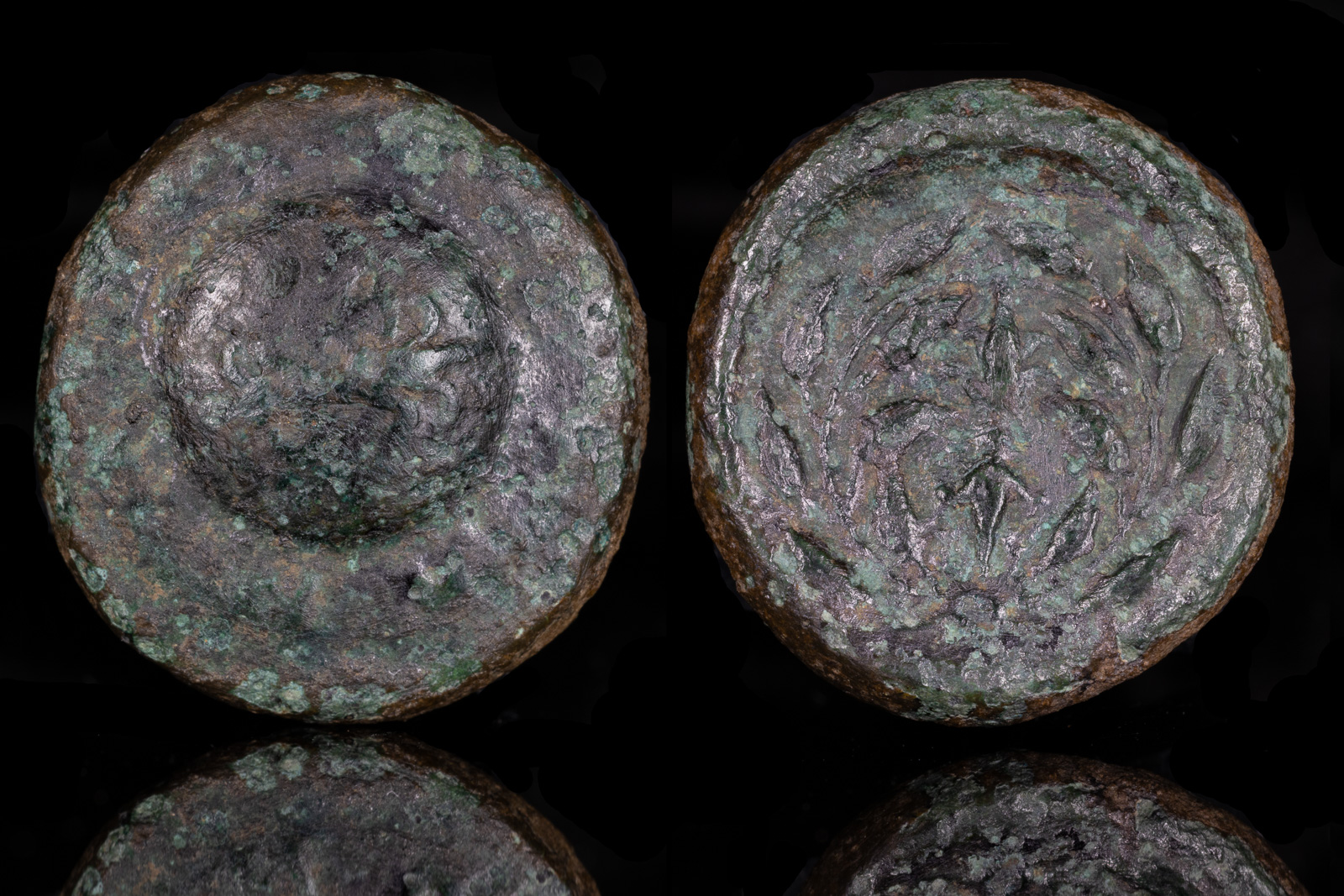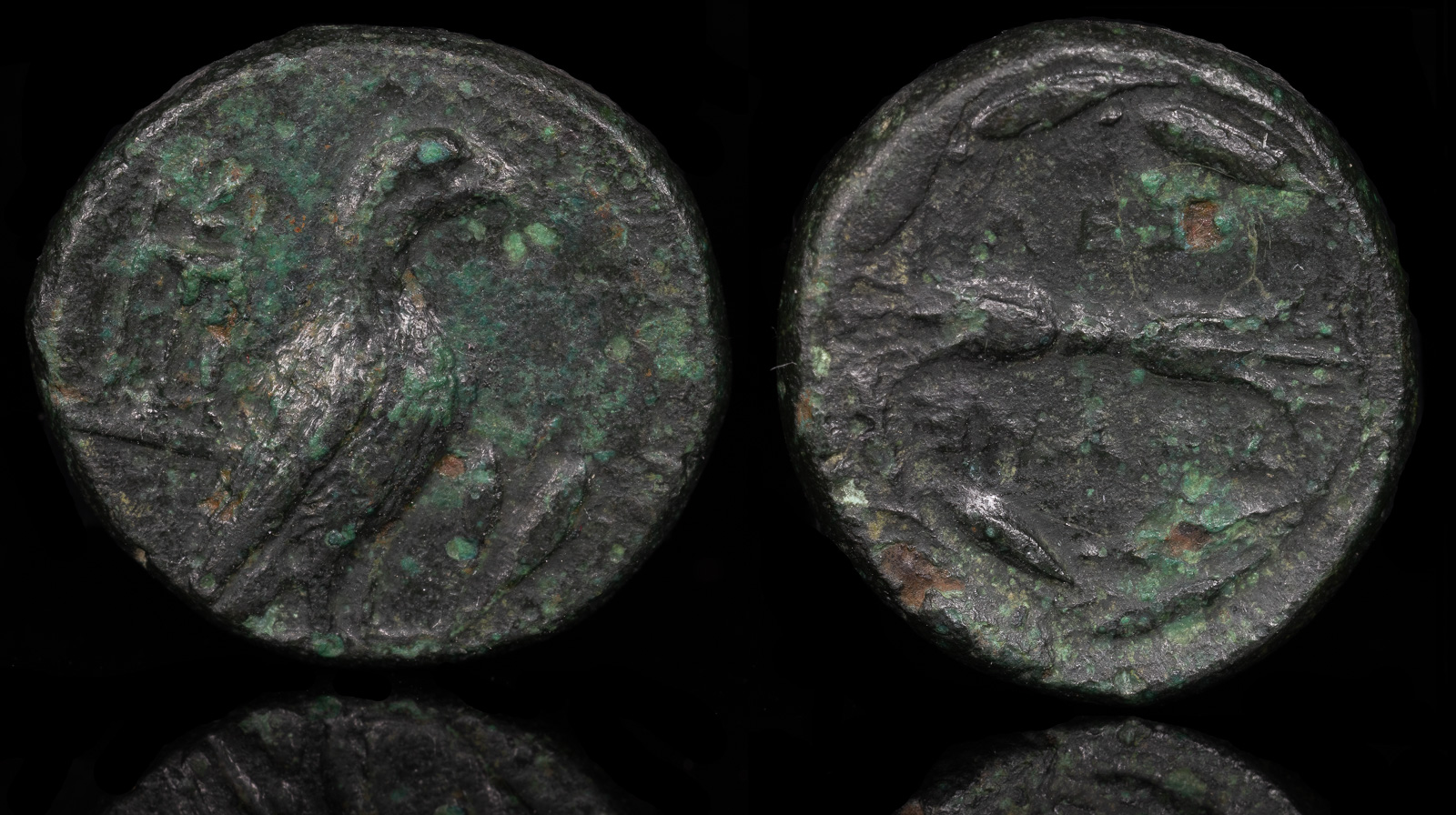
Alexander the Molossian
Bruttium, Croton 334-331 BCE
AE 12mm 3.37g
Eagle standing to right; tripod to left, laurel spray to right /
Thunderbolt, ΑΛΕΞΑ above, TOY NE below, all within wreath
SNG Copenhagen 90
Attianese, Calabria Graeca, 267,510
Ex Collection of M. Weder
Ex Münzen & Medaillen GmbH
Everyone’s heard of Alexander the Great. But have you heard of the Alexander Who Was Not So Great?
Yes, in Alexander III‘s own lifetime there was the fabulously confusing Alexander I, more often referred to as Alexander the Molossian to avoid a mix up with the first major king of Macedonia. Alexander the Molossian’s introduction into high society was rudely interrupted when, during his wedding to Alexander III‘s full sister Kleopatra, the Macedonian king Philip II was assassinated.
The whole wedding had been designed as a strengthened alliance between the the two states. In a previous episode, the Molossian’s sister, Olympias, had returned to Epeiros all pissed off at her husband. She couldn’t stand that he was sleeping with other women, marrying other women, having children with other women, and – most horribly at all – dishonoring her own Alexander. She was demanding war. So, the Molossian had ventured down to Pella, chatted with Philip II, perhaps slept with him, and after a great night of drinking the two had setup this wedding. And now it was ruined.
There was a lot of awkwardness. Should the wedding presents be sent back? Those honeymoon tickets to Tahiti certainly needed to be cancelled. Nevertheless, while everyone was sorting out the mess and Alexander III and his mother Olympias were making a list for the next ‘Survivor Macedonia’ series (spoiler: everyone selected was eliminated), Alexander the Molossian took his bride back to Epeiros and got busy.
They had two children: Neoptolomos and Cadmeia. Neoptolomos would later star in their own ‘Survivor Epeiros’ episode, in which he was paired with Pyrrhos and was eliminated. Cadmeia remains a mystery, and there’s some archeological evidence (some plaques mentioning descendants of Olympias) that her line may have continued as the last descendants of Philip II.
As we all know, Alexander the Great marched off to Persia in 334 BCE where he achieved great success. Indeed, his likeness was on every child’s lunch box across Greece and the Balkans, and the Molossian was insanely jealous. Well, if Alexander was going to take the eastern half of the world, he would take the western. There was only one slight problem. The Molossian had the congeniality of a slug. He also didn’t have much of an army.
All that changed one day when he was reading the newspaper.
Wanted. One megalomaniac to aid and command our city against some pesky Italians. Must have experience with phalanxes. Exiles and bastards need not apply. Please send list of previous wars, two references, and a resume.
The Molossian immediately applied and was soon leading a force of Tarantines and mercenaries against several Italic tribes. He was successful at first, and dreams of empire soon filled his head. He would start with Italy and then proceed through the rest of Europe. The only problem was, the Italians – his allies included – didn’t really want to be conquered. Those bastards!
Eventually, his allies tired of him and he was double crossed and killed.
Far away, Alexander the Great was reading his newspaper when he learned of the Molossian’s death. He shook his head and moved on to the comics. In Epeiros, his wife cleared out his garage for her own carriage, took his throne, and redecorated the palace. She would rule Epeiros alone for several more years.
I have several coins minted by Alexander I Molossos. This is the first I purchased.
This was minted in Italy to pay his troops. One thing I really love about it is it came from the collection of Markus Robert Weder (1953-2016), who was more known for his work in Roman numismatics but worked in the British Museum and for Leu. I don’t have many coins, given my budget, that have much of a provenance, but I think it’s cool that someone who worked for the British Museum(!) found this coin and liked it enough to acquire it.
As the coin above was minted in Italy, I wanted something minted in Epeiros itself, so I purchased this one.

Epeiros.The Molossi
AE Circa 360-330/25 BCE
Æ 19mm, 6.16g
Vertical thunderbolt on shield
R/ Vertical thunderbolt within wreath
SNG Copenhagen 53.
Ex Bertolami Auction 44 (Sep 2017)
This is the closest coin I can attribute to Kleopatra, the only woman recognized for ruling alone during this period. Adea aka Eurydike would later hold Macedonia itself for over a year, though in name it was controlled by her husband Philip III, and in practice by her.

Alexander, King of the Molossians
Epirus, 342-330 BCE; c. 334-332 BCE
AE 15.5-16.5mm, 3.57g
Obv: Eagle standing r. between tripod and laurel spray.
Rx: ΑΛΕΞA /ΤΟΥ ΝΕ above and below thunderbolt; all within wreath.
BM-6, SNG Cop-90, Sear-1987.
Ex Mark Gibbons Collection
Neoptolemos I, father of Alexander I Molossos, dies. His brother Arybbas, with whom he had jointly ruled Epeiros, becomes the sole king.
Alexander I Molossos brought to Macedon under Philip II for his protection.
October 25
Alexander the Great becomes King of Macedon when his father, Philip II, is murdered at the wedding of his sister Kleopatra and Alexander I Molossos. Perdikkas helps chase down and kill the assassin.
Alexander I Molossos joins the city of Taras against Italic tribes. Kleopatra serves as regent of Epeiros.
Alexander I Molossos defeats the Samnites and Lucanians. He makes a treaty with Rome.
Metapontion signs an alliance with Alexander I Molossos.
Alexander I Molossos is killed at the Battle of Pandosia when he is betrayed by Lucanians.
The remains of Alexander I Molossos are interred at Metapontion.